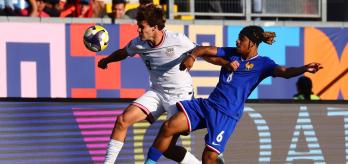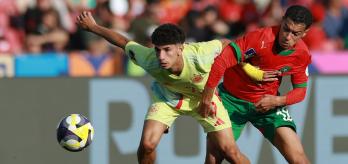With 106 goals scored at the same stage of FIFA U-20 World Cup Argentina 2023™, the tally of 107 this year indicates some parity in both competitions. Goals scored with the head are down -11, while goals scored with the right foot are up +19. Furthermore, while the open-play cross completion rate remains steady, with 23% in 2025 and 22% in 2023, nine more goals have been scored from crosses when the group stages of both tournaments are compared (25 in 2025 and 16 in 2023).
There has also been an increase in the proportion of goals scored in the 0-15-minute time sector in matches, up from 7.8% in 2023 to 16.2% in 2025, while an increase has also been noted in the opening 15 minutes of the second half (45-60 minutes sector), rising from 14.7% to 18.1%.
Changing game tempo: Marcelo Jara
For former Chile national team player Marcelo Jara, the way teams have dictated and changed the tempo of their play has also been a point of interest in this tournament to date.
“I really like how teams are alternating the speed of their play, depending on the game situation. This shows a high level of game awareness and intelligence from these young players. We have seen teams attacking at a moderate pace, or even a slower pace, luring the opposition team into a pre-defined area of the pitch. Then, these teams know their route out and quickly change the point of attack with an injection of pace and speed.
“I’ve been very impressed by the way young players and teams manage this game situation. In clip 1 below, we see an example of Colombia’s play, where they move their opponent and find space to advance. This requires very strong technical, tactical, physical, and psychological skills: passing and controlling; identifying the receiver who offers a chance; moving at the right moment; and then deciding the next move to advance or score.”
In addition, Jara cites the impressive decisions taken by players.
“It requires preparing the players in game principles that will allow the available space to be used effectively for the game plan. We’ve seen verticality, with movements and passes to break lines, or to leave a team-mate with an advantage on the opposite side of the pitch. The mobility and support generated in other spaces are crucial for progressing the ball on the field and going towards the goal. The players’ ability to change phases at speed is considerable and remarkable. They show real maturity in their thinking and actions with great concentration, mentality, and tactics, which has been reflected in the team’s performance so far.”
High block and the 1-4-4-2: Corinne Diacre
It has been observed in this tournament that many teams are using the 1-4-4-2 team shape as the platform for their pressing strategies when they do not have the ball. Interestingly, this system is being used by teams when they are high pressing, or in a high block, and when in a mid-block, as Les Marseillaises head coach Corinne Diacre explains.
“The best teams are pressing aggressively with great consistency. We are seeing teams like Argentina, Japan, the USA, and Spain press high when they can and with controlled aggression. They also do it in the game consistently, regardless of the score, which shows strong intention. This is interesting, as we often see teams press high in stages and then, sometimes, drop off, depending on the score, or they become a little more conservative if they take the lead in the match. The quality of the substitutes also helps the consistency for teams that want to do it for the whole game, because it is clear they know their roles in the team when they enter the pitch.
“In this tournament, many teams are pressing high against their opponent’s goal kicks and looking to disrupt their build-up or force them to play long. The 1-4-4-2 is commonly used out of possession, as it gives the defending team good scope to cover the pitch, protecting the central channels, but also to get good pressure applied in the wide areas.”
Controlling the game in and out of possession: Marcin Dorna
As Dorna explains, “After the group stage, it is evident that modern U-20 teams are balancing structured organisation with proactive play. Whether in or out of possession, there’s a trend toward speed, compactness, and strategic risk-taking. The most successful teams are those who can both dominate the ball and defend with discipline, initiative and aggression.
“In possession, the best teams are always looking to break down compact defences with well-timed forward runs. This off-the-ball movement stretches their opponents’ defensive line and creates more chances, showcasing a shift toward more vertical and direct attacking play. A clear trend is the preference for quick ball circulation, both long and short, with an emphasis on progressing the ball forward quickly. This approach helps unsettle defensive blocks and opens spaces between the lines.”
Additionally, Dorna notes that, “Teams have a strong appetite to control the game when they do not have the ball by using coordinated pressing actions after losing possession. There’s a clear intention in the first few seconds after loss of the ball, as teams are implementing high-intensity counter-pressing to win the ball back quickly and prevent counter-attacks. A key component to this is how they set up their rest defence, and teams that have worked on this are better at sustaining pressure, limiting counters, and controlling the game’s rhythm.”
Goalkeeping: Pascal Zuberbühler
The in-possession role of the goalkeeper is becoming increasingly important at senior level, and observing how youth goalkeepers are developing the skills and techniques that first-team football will demand of them is a keen point of interest for our senior goalkeeping expert, Pascal Zuberbühler.
Long kicks
“It is interesting to see how the distribution of goalkeepers impacts the point of attack for their team. We already know how good they must be with their feet, but in this tournament, we are seeing the development of their decision-making, especially when under pressure. We are seeing more long balls being delivered over the opposition’s defensive line, and these are intentional tactical decisions designed to expose the space behind the opposition’s defensive line.
“This supports our observations that teams are varying how they play, making them less predictable and responding to the way their opponents are pressing. The goalkeepers are fully engaged in all moments of the game and are offering to receive from their own players to stretch the opposition’s team shape to create numerical advantages in build-up.”
Defending corners
“I have also been impressed to see how proactive and assertive the goalkeepers are when their team is defending set plays. They are brave and are securing a lot of first contacts after the ball is delivered into the penalty area, whether their team-mates are set up with zonal marking or player marking, and this is interesting because both scenarios can be different for goalkeepers.”















